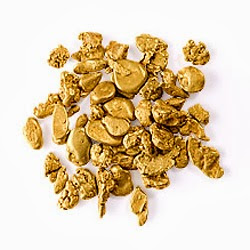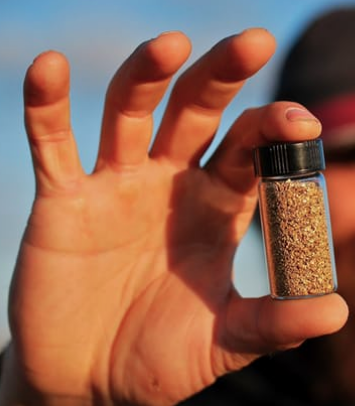Monday, February 19 2024
Gold is generally considered a time-tested safe-haven asset, the price of which has historically held up well in times For those of us afflicted with gold fever and who enjoy prospecting and mining as a hobby, the price of gold doesn't make much difference. Most small-scale prospectors seem to get much more pleasure from the process of finding the gold rather than selling it. It's the thrill of the hunt! And, of course, all the great memories you make. Plus, it's just plain old fun buying a new highbanker or gold wheel. Even if you have no intention of selling any of the nuggets or fine gold you recover, you still might be wondering where the price is going from here. Whether or not gold has reached its peak is a point of contention.What drives the price of gold can be confusing and conflicting. While other commodities are mostly driven by supply and demand, gold is often affected by the psychological effects of economic downturns. Gold prices are affected by numerous economic factors such as: • Value of the U.S. dollar Numerous factors influence gold pricing, so no one person or organization is fully responsible for setting prices. However, the London Bullion Market Association (LBMA) publishes gold prices twice a day via the ICE Benchmark Administration (IBA). The IBA consists of multiple banks, an oversight committee and a panel of internal and external chair members. The IBA sets gold spot prices and gold fixed prices based on supply and demand as well as the gold futures derivative markets. If you do want to sell your gold, you can sell to a variety of buyers, including precious metals dealers, refiners, coin dealers, and jewelry makers. Research potential buyers and compare prices before selling to ensure you receive the best possible price.The amount of market value you can get depends on several factors: • Quality and Purity: The value of gold is determined by its weight and purity. Higher-quality, purer gold is worth more than lower-quality, less pure gold. A gold prospector will typically have their gold assayed to determine its quality and purity.
Saturday, December 05 2020
With gold prices on the rise, you might be wondering if now is a good time to sell some of the gold you’ve found over the years. And if Gold dust consists of flour, fines and flakes. This is the stuff most prospectors find as a result of panning, sluicing and dredging. This form of gold is probably the lowest value because it will have the most impurities. Small nuggets start at about 1 gram and are a step up from gold dust in value. Medium nuggets, on average, weigh up to 31 grams or 1 troy ounce. Large nuggets are defined as weighing 1 troy ounce or more. Larger nuggets usually command higher prices, and could be considered museum quality. Gold in quartz is usually a collector’s item or a museum piece, therefore, prices widely vary. Keep in mind, though, that even nuggets that appear to be pure gold are not. They will have impurities embedded and blended into the matrix. There is no such thing as 100% pure gold from nature. In fact, in North America, the average purity for prospected and mined gold averages 60% - 85%. The impurities in natural gold consist of metals such as silver and copper and other minerals that have combined with gold on a molecular level. Tests, referred to as an “assay” must be performed to accurately measure the purity of gold. Some jewelers and pawn shops can analyze your gold to determine purity with an XRF gun (X-Ray Fluorescence); expect to pay a charge for that service. The majority of gold bought and sold from small-scale prospectors include: private buyers (some advertise on eBay, Craigslist, and other online sites) pawn shops, independently owned jewelry stores that craft and repair their own jewelry, museums looking for unusual specimens or rare nuggets, and refiners. Most refiners are contracted by large gold mining operations, but some smaller refiners will purchase gold from prospectors in any form or mesh size. An internet search will reveal refiners that will buy from individuals. If you want to sell your fine gold or nuggets, there are a few things to do first. You may not get a totally accurate assessment of your gold’s value, but you’ll at least have a ballpark estimate. Do NOT melt your gold. Keep it in its original form.
When you make contact with potential buyers who specialize in raw and natural gold, be sure to ask about and understand their procedures and policies and payments. Ask how your gold will be assayed and how the purity is determined. If you are shipping your gold to a buyer, understand their requirements for packaging and shipping, insurance, and other safeguards. Some buyers pay for the testing and shipping, others pass along the costs to the seller. Remember that buyers have costs and will not pay 100% of the spot price. The exception to this would be if you have museum specimens or very large nuggets. In those instances, buyers will pay more than the spot price. Be patient and shop around to not only get the best price, but to find a buyer who you can work with now and in the future. Get recommendations from fellow prospectors, or clubs such as GPAA (Gold Prospectors Association of America). If possible, make your first transaction with a new buyer a small one to assess your experience and satisfaction with the overall sales process. When you feel you have had a successful first transaction, you’ll feel confident you can continue that relationship in the future. If you've not yet found your first gold, get Alaska paydirt here. Friday, March 02 2012
Ever wonder how much gold has been mined in all the world? The best estimate at the end of 2011 is that around 165,000 metric tons (or tonnes) have been mined in all of human history. That’s about 181,881 ordinary tons or 363,762,732 pounds, or 5,820,203,717 ordinary ounces. Gold typically is measured in troy ounces, which are a little bigger than ordinary ounces (a troy ounce is 31.1034768 grams whereas an ordinary ounce is 28.3495231 grams). There are 32.1507466 troy ounces in a kilogram or 32,150.7466 troy ounces in a metric ton. Thursday, February 02 2012
What's the Difference Between a Karat, Carat, and Carrot?
The purity of gold is measured in 24ths called karats. 24K gold or 24-karat is 100% pure gold. 18K gold or 18-karat is 75% pure, and 14K or 14-karat is 58.3% pure. The value of gold can further be determined by its rarity of structure-- whether it is a nugget or wire gold or has specimen value. Gemstones are weighed by the carat (notice the difference in spelling) -- which is 200 milligrams or one-fifth of a gram. There are 5 carats in a gram. In addition to weight, the value of gemstones is also set and judged on their color, clarity, and cut. If you're hungry, choose a carrot! Monday, April 04 2011
Where can you fetch the best price for the gold you find? Refineries are probably the best answer for most prospectors if you have at least two ounces of gold to sell. That might sound like a lot, but if you collect all sizes and shapes of gold over time, then sell it all at once, it's the most profitable for you. Refineries don't care if it's fine gold, pickers, nuggets, or a combination because they melt it all down and resell it by weight. They do not care about the size or shape of your original gold, they only care about the purity.
In general, refineries pay around 95% of assay (assaying is conducting a gold purity test). That means you get 95% of whatever purity is determined (85% pure is pretty common), minus a refining fee. Using $1,400 an ounce as an example price, if you sent in an ounce of gold and it was determined to be 85% pure, you would get about $1,130.50 for your ounce, minus a refining fee. Not too bad considering you can live anywhere and send any size or type of gold to the refinery of your choice! |
|
Nugget of News Blog |






 of high inflation, market volatility and geopolitical uncertainty. Gold is a finite resource, and therefore increases in value over time. Knowing this, many investors turn to the precious metal in an effort to protect their money. And those holding it in their portfolios were rewarded in December 2023 when the price of gold hit an all-time high of $2,135 per ounce! Analysts say that record price was driven largely by a weak U.S. dollar and expectations the Fed will begin lowering rates.
of high inflation, market volatility and geopolitical uncertainty. Gold is a finite resource, and therefore increases in value over time. Knowing this, many investors turn to the precious metal in an effort to protect their money. And those holding it in their portfolios were rewarded in December 2023 when the price of gold hit an all-time high of $2,135 per ounce! Analysts say that record price was driven largely by a weak U.S. dollar and expectations the Fed will begin lowering rates. 